When you take your first bite from a warm slice of dutch oven sourdough bread, you’ll realize that nothing tastes better than bread made from scratch at home! This classic no knead sourdough recipe has just 4 ingredients, and the dough can rise throughout the day or overnight. With a little patience and our pro tips, you can be enjoying a homemade loaf before the end of the day!
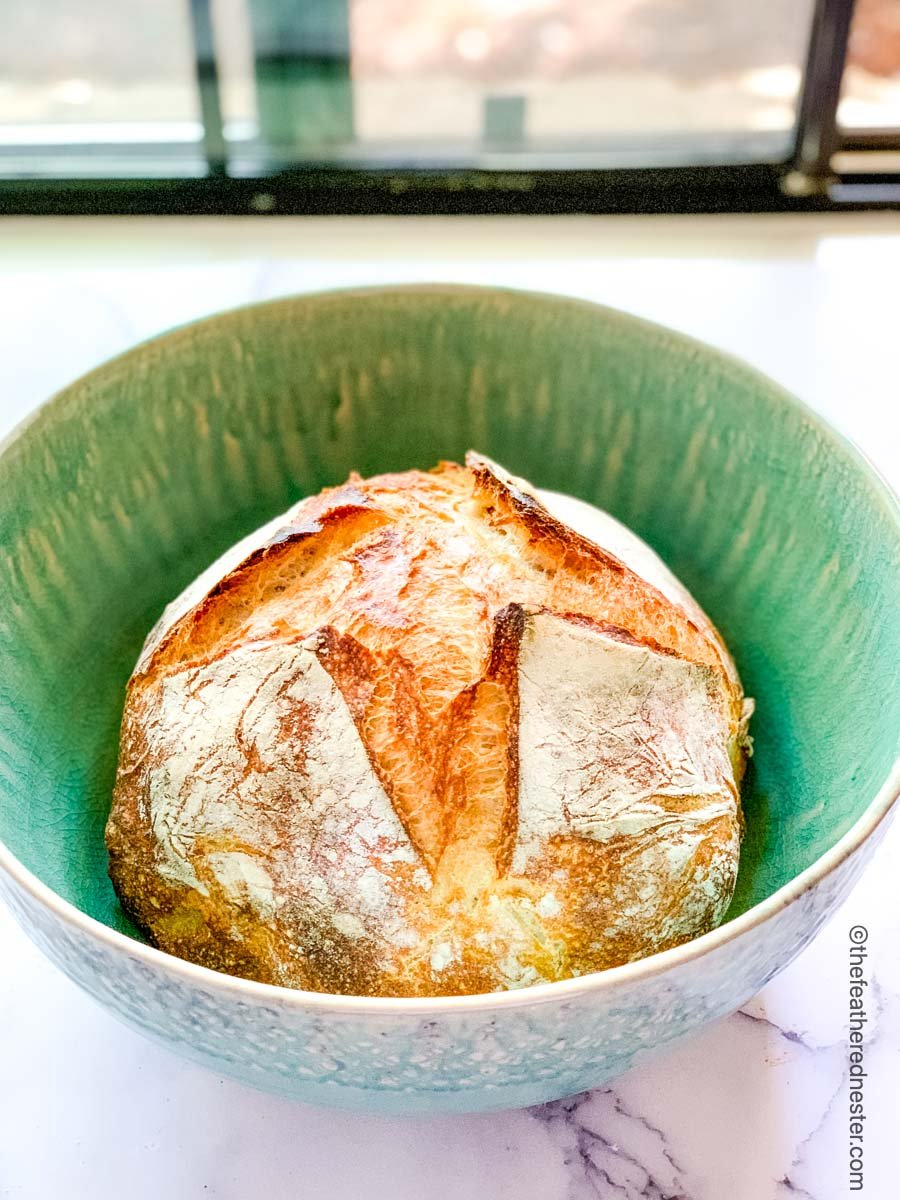
Content Covered Here
Why We Love This Recipe
- This no knead sourdough recipe makes a classic round boule, baked in a Dutch oven. The method yields a rustic, artisan-style loaf that is slightly crispy and chewy on the outside, and fantastically fluffy and soft on the inside.
- Each bite has that signature sourdough tanginess that will have you craving another slice.
- For those who live in colder climates, you’ll love that the dough can be left to rise during the day versus overnight – when it’s typically colder and therefore more difficult to get a great rise in the evening.
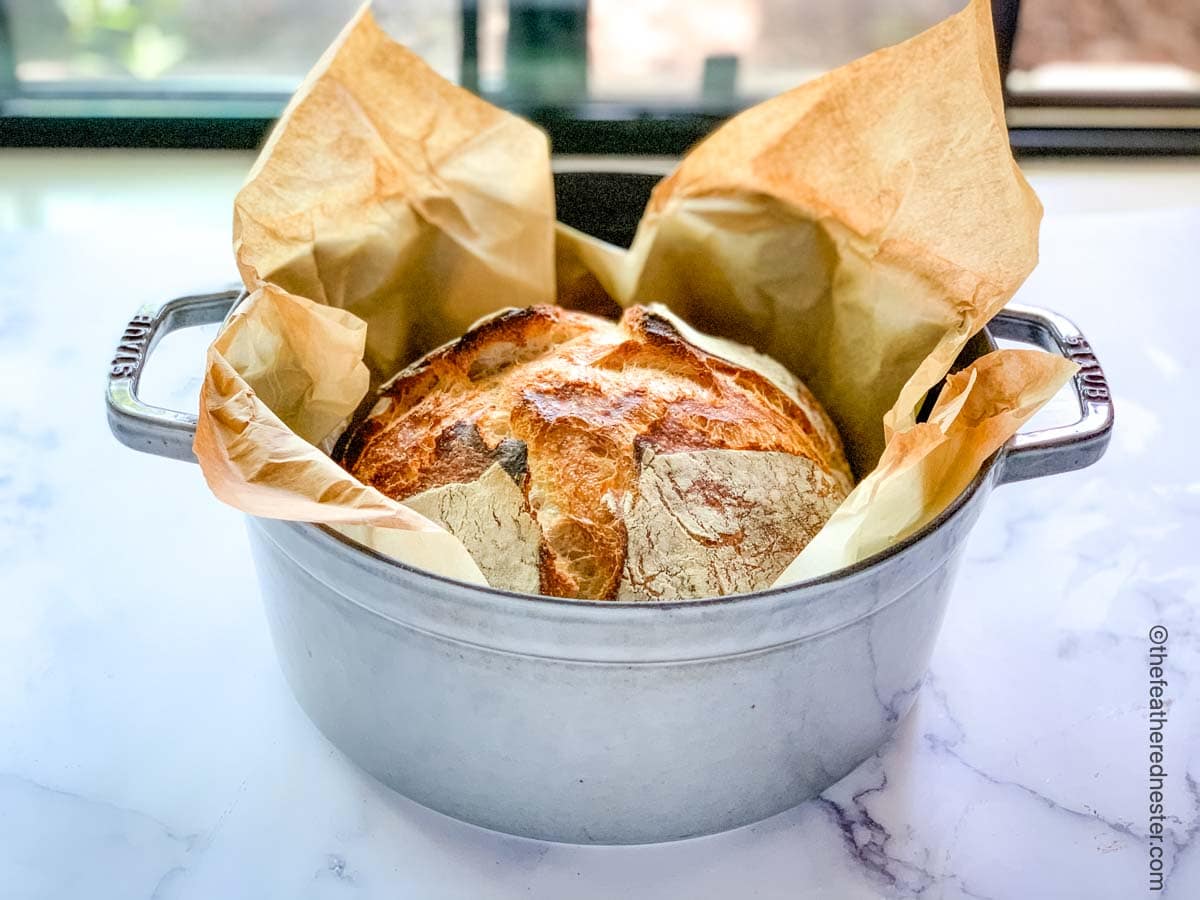
Sourdough is fantastic for making all kinds of tasty baked goods. From sweet treats like sourdough apple coffee cake to savory pizza crust, a good sourdough starter is about the most versatile ingredient in the kitchen!
Ingredient Notes and Substitutions
There are only 4 ingredients (including water) needed to make a delicious loaf of sourdough bread from scratch:
- Sourdough starter – is absolutely necessary for this recipe. Feed your starter 12-24 hours prior to starting the recipe.
- All-purpose flour – you can substitute bread flour for some of the all-purpose. See the recipe cards for exact amounts.
If you’d like to make a whole wheat loaf, we recommend making our no-knead whole wheat sourdough bread recipe instead! - Salt – any type of salt works. If you use Kosher salt, increase it by 25%.
- Warm filtered water – ideally, the temperature of the water should be about 105°F or baby bottle warm. If the water is too hot, it will damage the starter and you’ll have a flat loaf.
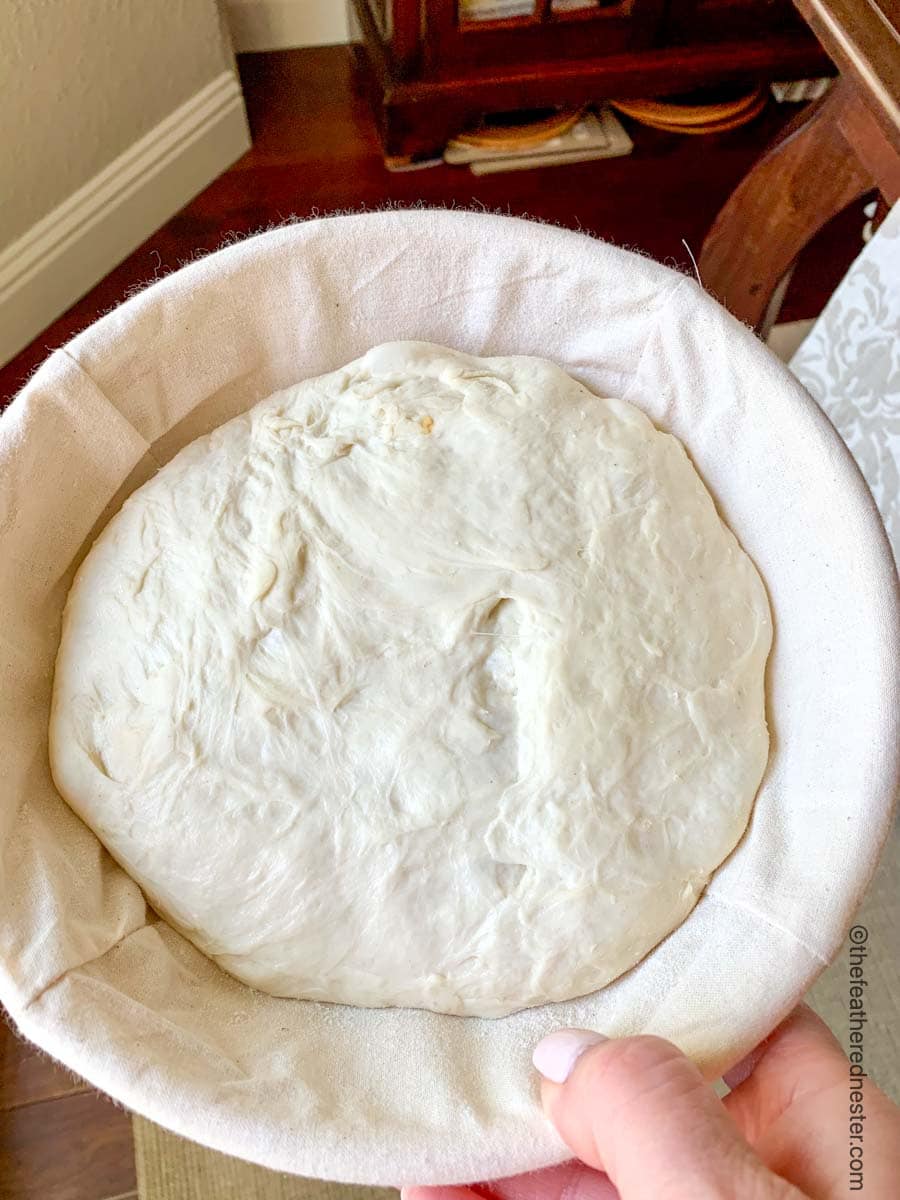
Recipe Variations
If you prefer extra tangy sourdough bread, replace 1/4 teaspoon (up to 1/2 teaspoon) of the salt with citric acid or sour salt for a tangy kick to your sourdough.
Are you looking for a soft sourdough bread that is not baked in a Dutch oven? Super soft sourdough sandwich bread is great to keep on hand for lunches (kids love it!), and a is always welcome on the dinner table.
Equipment and Supplies
We recommend using a 4-quart to 5-quart Dutch oven for baking this sourdough bread recipe. The smaller size supports the bread during its fast rise in the oven and provides a taller loaf.
A dough whisk is handy for stirring the thick batter.
Using a clear bowl for rising makes it easier to see the fermentation activity going on below.
Plastic wrap to cover the bowl during fermentation keeps the dough from drying out if you live in a dry climate.
Tools We Used For This Recipe
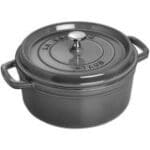 Buy Now →
Buy Now →  Buy Now →
Buy Now → See our sourdough recipes or our list of sourdough recommend tools.
How to Make Sourdough in a Dutch Oven
Below are the foolproof step-by-step directions for making this amazing bread. You’ll love how easy (and delicious!) this bread is!
Mix the Dough
- Add the sourdough starter to a large glass bowl. Stir in the water until the starter is completely dissolved. Now add the flour and salt. Use a dough whisk or wooden spoon to stir until a thick and shaggy dough forms. If it’s too thick you can finish mixing the dough by hand. Leave the dough in the bowl, and cover it with a clean and slightly damp kitchen towel. Let the dough rest for 30 minutes.
- Next, activate the gluten by stretching and folding the dough for 15 seconds in the bowl. To watch the technique, check out the video tutorial on the recipe card at the bottom of this post.
Grab the edge of the dough, stretch it up, and press it down into the center of the dough, then turn the dough 1/4 a turn. Continue stretching the dough as you move in a clockwise rotation. - Cover the bowl with a clean damp towel (or plastic wrap if you live in a dry climate), and let it rise in a warm area (70º to 80º F). If your room temperature is less than 70ºF the rise time will take up to 12 hours (see recipe notes for a proofing time guide). The dough will have risen about double and look bubbly as shown below.
🎯 TFN Pro Tip
If the ambient temperature is less than 70°F, you may need to let the sourdough rise for up to 12 hours. See the recipe notes for a fermentation rise time guide.
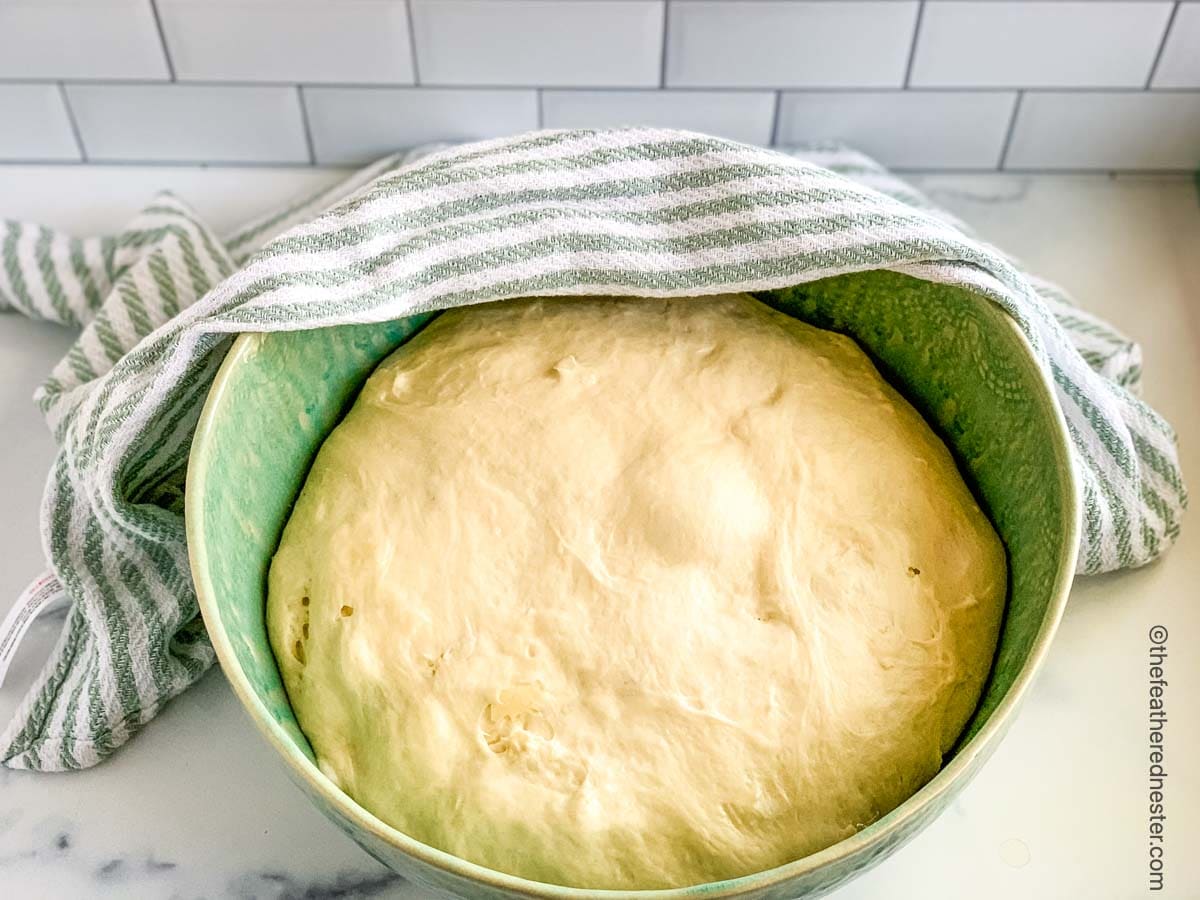
Shape the Loaf
- Now let’s shape the loaf. First, flour your countertop, and tip the dough from the bowl onto the countertop. Stretch and fold the dough again as you did before. Let the dough rest for 10 minutes.
- In the meantime, line a medium bowl with a towel or use a banneton with a linen cover (see photo), and dust heavily with flour. Transfer the dough to the bowl and let it rise for 30 – 60 minutes.
Bake the Bread
- Preheat your oven to 450º (without the Dutch oven). Cover the dough bowl with a long piece of parchment paper, and turn it over onto the countertop so that the dough is on top of the parchment paper. It should hold its shape well.
- Next, slash the top of the loaf with a lame or sharp serrated knife. This will allow the steam to escape and the crust to expand without cracking. Gently lower the parchment paper with the dough into the Dutch oven.
- Bake the Dutch oven with the bread covered for 30 minutes. Then remove the lid and bake for another 20 minutes. Use oven mitts to carefully remove the bread from inside the pot (on the countertop using a trivet is best) and bake the loaf directly on the oven rack for 10 minutes. This is essential to create that perfectly crisp exterior.
- Remove from the oven and let the sourdough bread cool for at least 1 hour before slicing and serving.
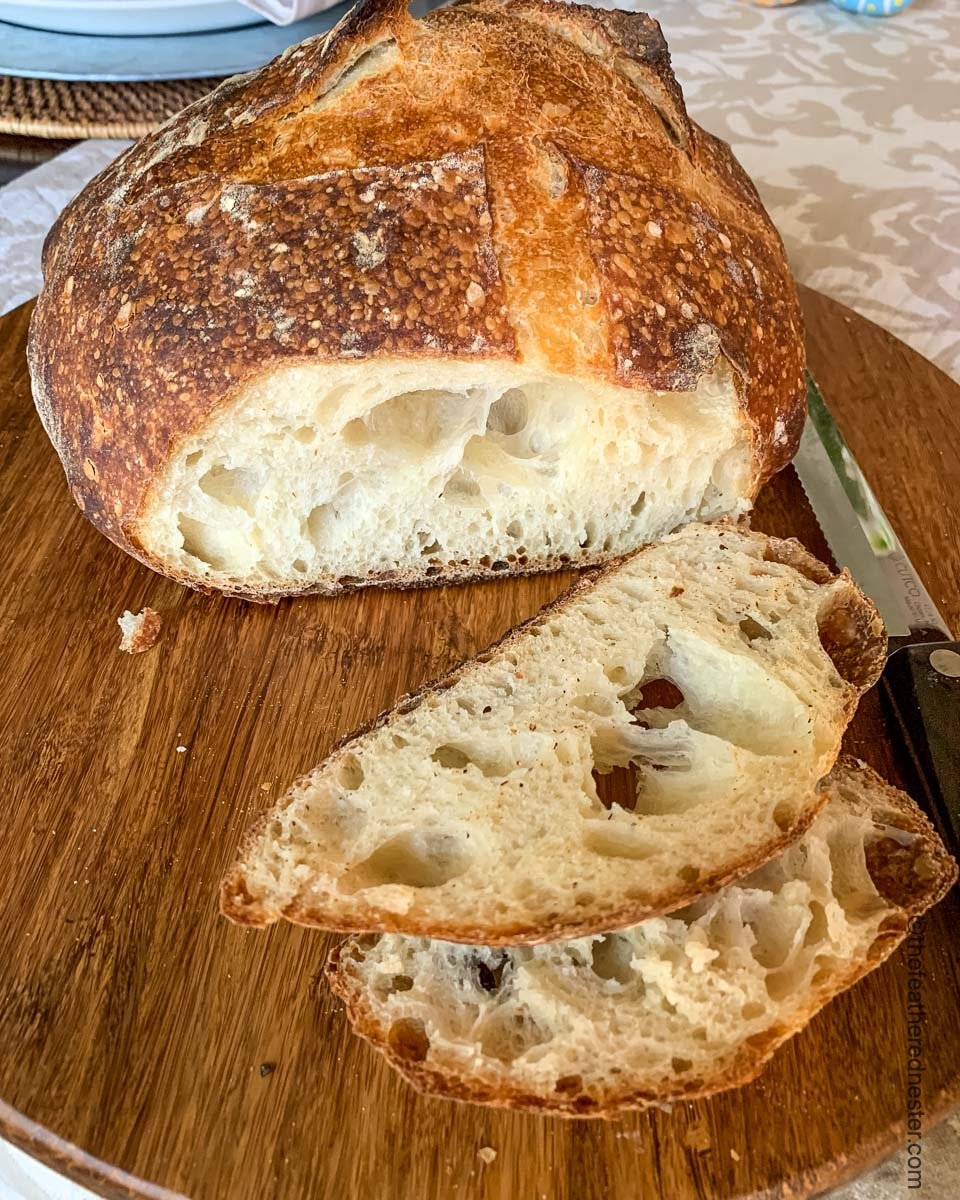
Recipe Tips
- Using a round Dutch oven will give you the typical round sourdough loaf. But, you can use an oval pot instead.
- Use the same brand of flour for consistent results. I prefer using King Arthur Organic All-Purpose flour, Arrowhead Mills Organic All-Purpose Flour, or Wheat Montana Premium All-Purpose Flour.
- Use a glass bowl to proof the dough. This will let you see the bubbles throughout the dough that let you know the dough is ready.
- Keeping the dough warm (70º to 85º is ideal) during the bulk rise is key for proper fermentation. See the recipe notes for actual rise times and tips below for how to keep your sourdough dough warm.
- If your Dutch oven has a dark bottom, like Lodge or Staub, use an oven-safe trivet or round silpat liner to keep the bottom from darkening.
Tips for keeping dough warm during colder months:
- Use a heated mat (like those used for germinating seeds) for rising.
- Use the “proof” setting of your oven (Renae sets hers to 85ºF) and set a timer. This will speed up the rising process, so check it at 4 and 6 hours.
- If there is a sunny room in the house that stays warm, keep the dough covered in that area.
- Place the bowl in the oven with the door closed and light on to create a slightly warmer climate without actually turning the oven on.
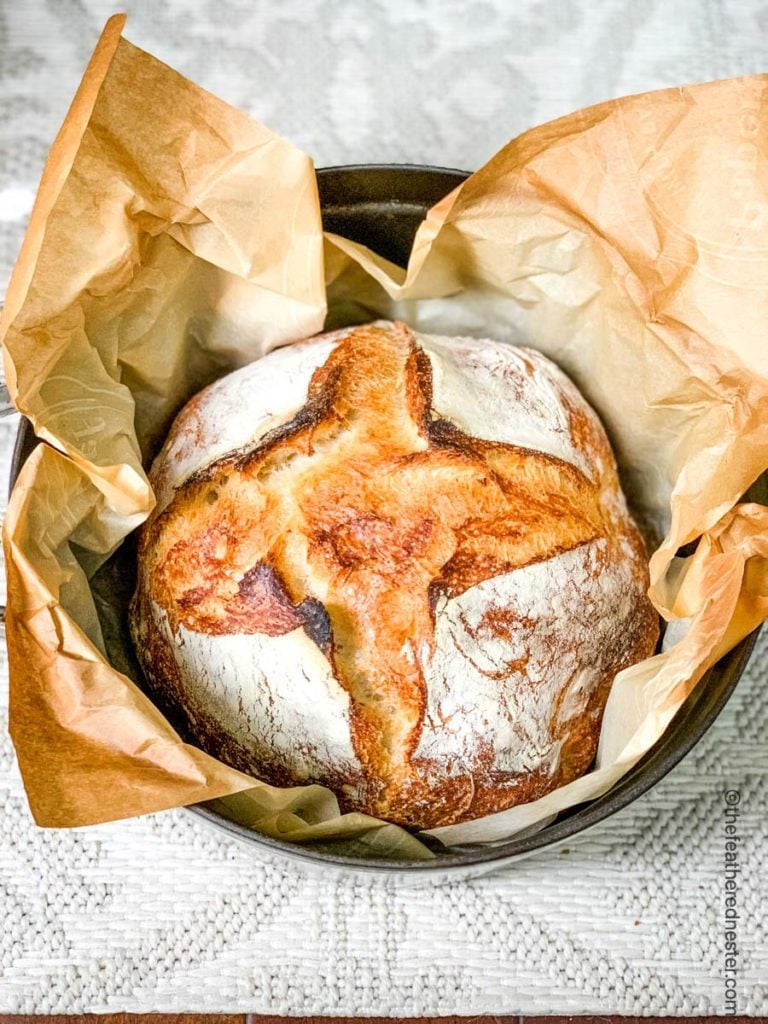
Recipe FAQs
When it’s ready, the dough should be about double in size, with a softer and smoother top. You should be able to see bubbles in the dough – this is where a glass bowl comes in handy. You’ll be able to see more bubbles on the underside of the bowl.
Yes, you can substitute all-purpose flour 1:1 with bread flour.
Substitute up to 1 1/2 cups of all-purpose flour with bread flour, but I do not recommend using all whole wheat flour as this yields a denser loaf. Also, add 1 Tablespoon of vital wheat gluten to get a higher rise.
Store sourdough in a sealed bag or container and keep it at room temperature for up to 5 days.
More Sourdough Discard Recipes to Try…
- Sourdough Discard Pizza Dough No Yeast
- Sourdough Cinnamon Rolls
- Sourdough Discard Banana Bread
- Grilled Cheese on Sourdough
If you tried this Dutch oven sourdough bread recipe or any other recipe on my website, please leave a 🌟 star rating and let me know how it went in the 📝 comments below. Thanks for visiting!
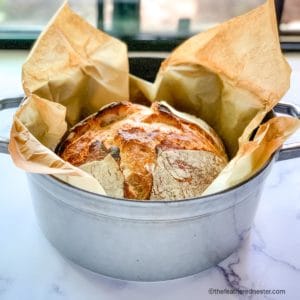
Dutch Oven Sourdough Bread
Equipment
- dough whisk - optional
- 4 to 5 quart Dutch oven with lid
Ingredients
- ¼ cup (60 grams) sourdough starter *fed within the last 12-24 hours
- 1 ½ cups (350 grams) filtered water about 100º F.
- 4 ¼ cups (500 grams) all-purpose flour *See recipe notes for using bread flour
- 1 ½ teaspoons (9 grams) fine salt *we prefer using sea salt
Instructions
- In a large bowl, add the sourdough starter. Add in water and use a dough whisk or a wooden spoon to stir until dissolved. Stir in the flour and salt until a shaggy looking dough forms. Finish mixing dough by hand in the bowl until all the flour has been absorbed. Cover the bowl with a clean, damp kitchen towel and let the dough rest for 30-45 minutes.
- Lightly flour your countertop. Pull the dough from the bowl with a dough scraper or by hand onto the countertop. Stretch and fold the dough for 15 seconds (see video below): grab the edge of the dough and bring it straight up it about 4 inches and tuck it into the center of the dough. Then, turn the dough 1/4 a turn. Continue this process until the dough has come full circle and it has tightened.Return the dough to the bowl, cover with a damp towel (or plastic wrap if you live in a dry area) and and let rise at room temperature or a warm area (70º to 80º F) for 4-9 hours (see chart in notes) to ferment. Do not refrigerate the dough. The dough should be about double in size and look puffy on the surface and bubbly under the dough when fermented.
- Lightly flour your countertop. Pull the dough from the bowl and shape the dough by stretching and folding it again. Let the dough rest 10 – 15 minutes. Line a medium sized bowl with a towel, or use a banneton bowl with linen cover (see photos), and dust heavily with flour. Let dough rise in it for 45-60 minutes.
- Preheat your oven to 450º (without the dutch oven). Cover the dough bowl with a long piece of parchment paper, about 20 inches long, and turn it over onto the countertop (see video). Slash the top of the loaf with a lame or sharp serrated knife. Gently lower the parchment paper dough into a heavy pot with a tight-fitting lid. NOTE: If using a Dutch Oven with a dark interior, I recommend insulating the bottom with a round silicone sheet underneath the parchment paper. You can also place the pot on a baking sheet. This helps the bottom crust of the bread from getting too dark in color.
- Place the covered pot in the the oven and bake the bread covered for 30 minutes. Remove the lid and bake 20 minutes. Using oven mitts, carefully remove the bread from the pot. Bake it directly on the oven rack for 5-10 minutes to crisp the exterior (if needed). To ensure your bread is cooked through you can check the internal temperature. It should be 195ºF to 205ºF.
- Let cool for at least 1 hour before serving.
Video

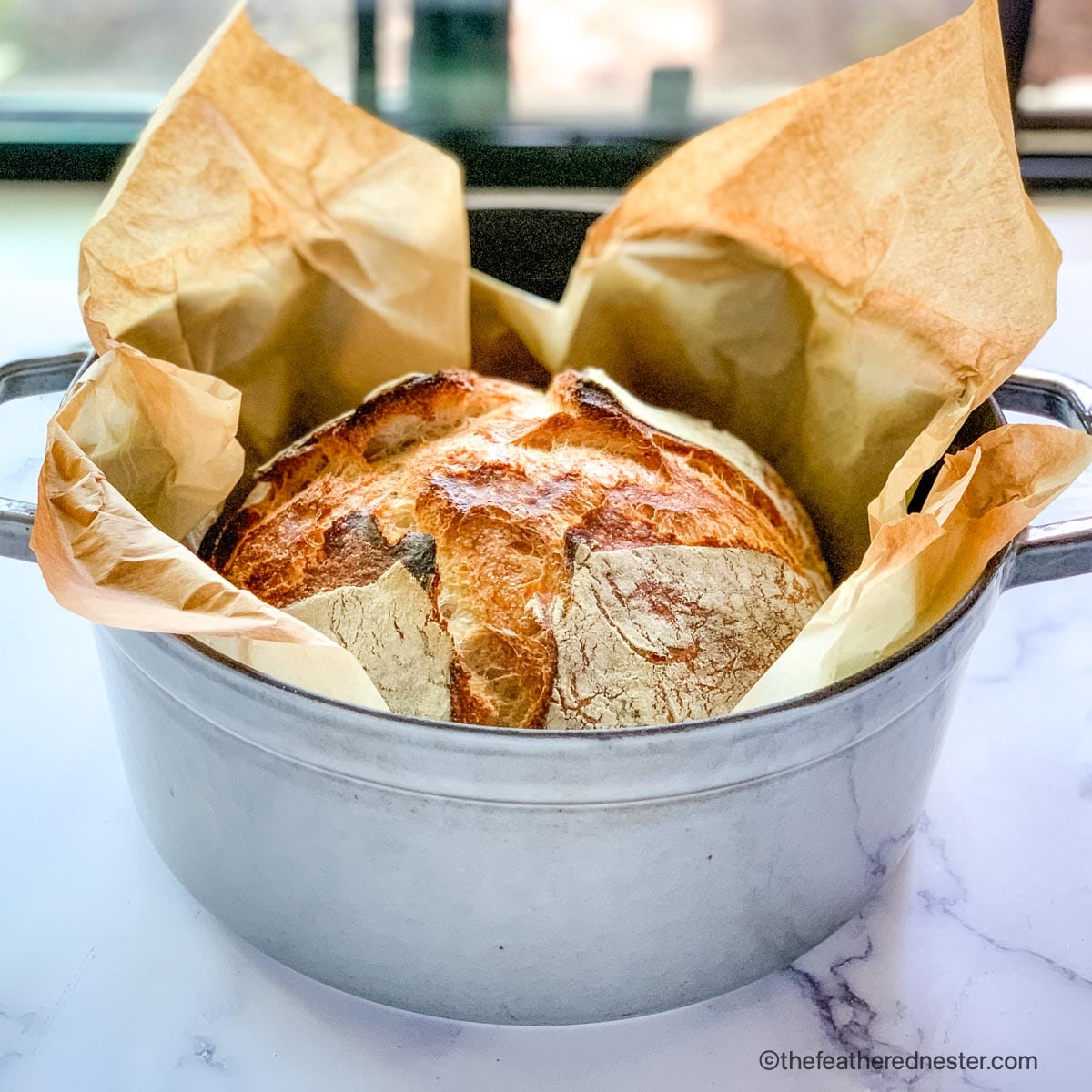




Megan says
This is the best sourdough recipe! I’ve tried a lot!!!! Thank you for all the best tips and tricks!
Maria Agosto says
Can I used spring water for the started or it has to be purified water?
Thank you!
Renae says
Hi there! You should be able to use spring water. The point of using filtered water is to avoid chlorine that could be in tap water, and I doubt that spring water has chlorine.
Tamela says
Love this!!! My daughters sent this to me, and I tried it. It has worked great!!!
Renae says
I love hearing this! Thank you.
Colleen Malecek says
I live in MN where it’s very cold in the winter.. can I use my proofing oven over night if I leave the door slightly open?
I’ve tried it in the oven with the light on and on top of the fridge to no avail.
I love the over night concept but have to get my proofing right.
I appreciate any help or suggestions you can offer!!
Thank you!
Colleen
Renae says
Yes, I think you could use your proofing oven. Even here in California, it has been difficult with my sourdough overnight rise as we keep our house at 63º to 65º at night. I have been tempted to let it rise in my wall oven at 85º overnight. Instead, I have been letting it rise about 12-14 hours for the fermentation bulk rise. I’ve been testing this recipe with whole wheat flour, so I have been making bread regularly these last few weeks.
Andy says
I’ve failed at making bread over the years, mainly due to not having enough patience and not paying attention to the details.
This method worked for me, twice so far and is so easy, I am ecstatic. If I can do it it must be impossible to get wrong.
Renae says
I can’t tell you how happy I am to hear this!